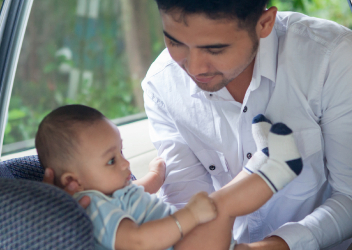Road Traffic Protection Research
The ability to safely get from one place to another is key to maintaining independence at all ages. This is why the Center for Injury Research and Prevention has been committed to road traffic protection research for more than two decades. Our road traffic protection research encompasses the lifespan -- from child passenger safety though older driver safety.
Because children are not simply "small adults," there remains a need for research into age-appropriate child restraint systems, vehicle designs for optimal child protection, and best practices for child occupant protection. Biomechanics data are needed to improve specific body regions of pediatric anthropometric test devices (ATDs), commonly referred to as crash test dummies, and to develop innovative restraint products to make vehicles safer for children in the future.
Older drivers have more driving experience than young drivers but also go through age-related changes that can affect their ability to recover after a crash.
Pedestrian and pedalcyclist safety is also an important part of road traffic protection. On average, a pedestrian was killed every 71 minutes and injured every 9 minutes in traffic crashes in 2021. That same year, 15% of children age 14 and younger who died in traffic crashes were pedestrians.
Our road traffic protection research is conducted by a multidisciplinary team of innovative scientists across disciplines that are addressing road traffic protection issues with evidence-based solutions.
Child Passenger Safety and Behavioral Science Research
The Center has been investigating child passenger safety and behavioral science for more than two decades, when its founders identified the deployment of front passenger air bags as a cause of fatal injury for children, even in minor crashes.
Crash Avoidance and Autonomous Vehicles Research

CIRP researchers are studying how teens and other vulnerable populations interact with highly autonomous vehicles and use crash avoidance systems technologies to inform vehicle design and increase safety for drivers, passengers. and pedestrians.
Low Acceleration Time Extended Events

This multi-year line of research seeks to define how occupants move as a result of swerving and how vehicle restraints interact with occupants during these maneuvers before a crash ever occurs.
Motion and Muscle Activation of Young Volunteers in Evasive Vehicle Maneuvers

Building on previous biomechanics research conducted at CIRP, this project examines responses of rear seat occupants to emergency maneuvers and is being conducted with research teams at the University of Virginia and The Ohio State University.
Older Driver Safety Research

CIRP is partnering with other research organizations to study older driver safety factors that influence mobility over the lifespan, including how many older adults maintain their driver's licenses and experience crashes and how prescription medication use in older adults affects their crash risk.
Pedestrian and Pedalcyclist Safety Research

CIRP is partnering with researchers from the University of Pennsylvania and other research institutions to study pedestrian safety and pedalcyclist safety, growing public health issues that are preventable.
Completed and Foundational Road Traffic Protection Research

For more than two decades, CIRP has been conducting research to improve road traffic protection, inform vehicle design, and promote safe behaviors through public policy and education.
Watch this video from Jalaj Maheshwari, MSE about how our researchers are using computational modeling in road traffic protection research:












